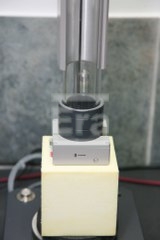1. Reaction Profile
This is the term given to the time for the foam to go through its different stages of reaction. The reaction is usually measured in seconds, with the time beginning as soon as the ISO and POLYOL components are first mixed together.
Cream Time – this is the first event measured, and occurs usually a short time after mixing when the mixed liquids turn “cloudy” in appearance and the liquid begins to rise from its initial stable state.
Gel Time – this is the time when the expanded foam begins to polymerise or gel. It is recognized by touching the expanded foam (with gloves or tools) and noticing a thin polymer strand or string, like a cobweb, being formed. At this time the foam should have filled the part or cavity. If the foam is still rising after the gel time this will cause stretch marks in the final foam.
Rise Time – this is when the reacted foam has reached its largest volume, or maximum height.
Tack Free Time – As the name suggests, this is when the final foam has lost its tackiness and can then be handled if required.
2. Density
Density is one of the main methods of categorizing foams. Density is expressed as weight per unit volume, so in most cases this is kg/m3 or lb/ft3.
In general, most polyurethane foams used for insulation purposes are in the density range of 28-34kg/m3 for optimal results. However there are many foams lighter than this down to 9kg/m3, through to foams of over 400kg/m3.
Naturally, the higher the density, the stronger and harder the foam is, and the more liquid chemical it will take to fill a cavity. Please click here for more information on Era Polymers testing equipment.
3. Thermal Insulation
The major use of rigid polyurethane foams is for thermal insulation. This is due to the fact that rigid polyurethane foams are one of the best insulating materials available to the insulation market today. Rigid polyurethane foam is widely used in insulation applications including roof insulation, wine tanks, cool boxes and cold rooms.
The insulation performance of a material is often measured in terms of the “k factor” which is a measurement of the rate of heat transfer through a unit thickness, across a unit area. The most common units for k factor are W/mK.
The other value often referred to is the “R value” which is a measure of thermal resistance, based on a certain thickness of insulation.
R value is calculated by THICKNESS (m) ÷ K FACTOR, to give the R value in units of K.m2/W.
4. Fire Properties
Polyurethane foams are carbon based and inherently flammable. However with the inclusion of special fire retardants into our formulas, the final foam product can meet various fire ratings. Era Polymers have foam formulations which have passed fire tests conducted by organisations such as Factory Mutual, CSIRO and BRANZ. For further information on fire requirements please consult your local Era Polymers representative.
5. Compression Properties
Rigid polyurethane foams have excellent weight bearing capacities for a given density, and can often be substituted for denser materials such as metal, wood, or rubber in composite core applications. As a general rule, the higher the foam density, the higher the compressive strength of the final foam.
Typically the compression strength is measured as the force required to compress a 100mm cube of foam by 10%. The compression test is conducted perpendicular to the rise of the foam, as well as in parallel to the rise of the foam.
Flexible foams also have good load bearing properties, with the advantage that they can recover from the compression once the load is removed and return to their original dimensions. This ability to absorb energy in a dynamic application is highly desirable in applications such as shock absorbers. The compression characteristics can also be tailored to give comfort in seating or bedding applications. See Closed Cell Content on testing page.
6. Resilience
Resilience, also referred to as rebound, is the percentage of height a ball bearing dropped from a certain height onto a foam rebounds. Typical resilience values for shock absorbing foams are 0-10%. In other applications where high frequency vibrations and quick recovery are required the rebound would typically be in the order of 20-40%. See Resilience on testing page.

